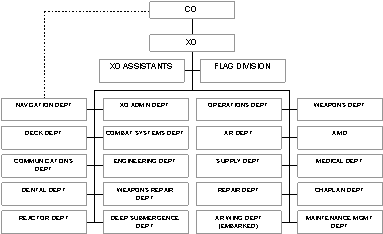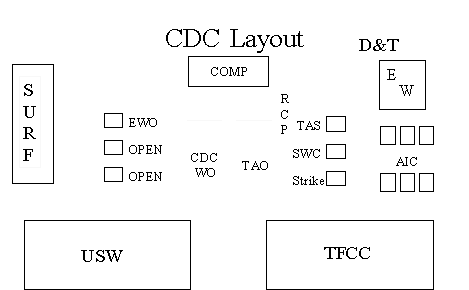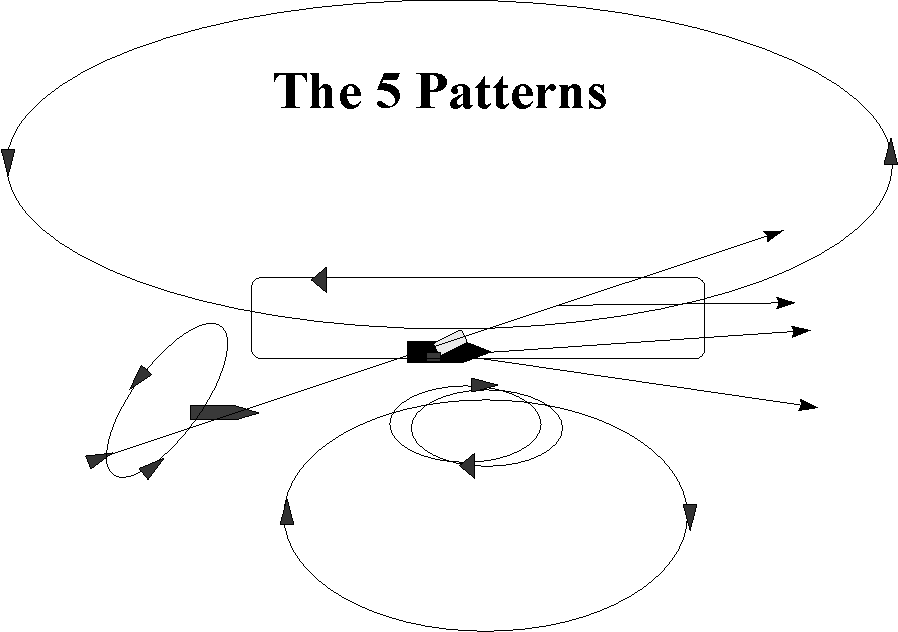 Deck Officer
Deck Officer  Deck Officer
Deck Officer INFORMATION SHEET
AIRCRAFT CARRIER ORGANIZATION
Information Sheet 1.23
INTRODUCTION
The purpose of this lesson is to introduce the standard organization and chain of command aboard an aircraft carrier as opposed to other platforms in the United States Navy. As a division officer you must immediately familiarize yourself with the chain of command, standard operating procedures, and daily routines for conducting business and interacting with superiors and subordinates in order to get the job done.
REFERENCES
(a) OPNAVINST 3130.6
(b) COMNAVAIRLANTINST/PACINST 3500.20
(d) NAVPERS 15839H
INFORMATION
A. DEPARTMENT ORGANIZATIONAL LAYOUT
NOTE: The following organizational layouts are, to a degree, tailored to best meet the operational requirements and maximize efficiency of an individual unit.

1. Figure 1.23-1 shows the most common types of departmental configurations. Deviation from these layouts may occur as necessary, but only the CNO will authorize additional departments.
2. Aircraft carriers (as well as surface combatants with complex, integrated combats systems suites) often have a combat systems department in lieu of a weapons department. In ships only assigned a helicopter detachment, an air department exists when the detachment is embarked. The detachment officer in charge is the department head.
Carriers, LHDs, and LHAs are structured with permanent air departments. In addition, on these platforms there exists a permanent safety department and aircraft intermediate maintenance department.
3. Given the daunting task of personnel administration and management onboard a carrier , Figure 1.23-1 shows the additional departments required. Specifically:
Figure 1.23-2 Typical Squadron Organizations
|
Squadron Type |
Departments |
|||||
|
Operations |
Admin |
Maintenance |
Safety |
Training |
Other |
|
VFA |
X |
X |
X |
X |
X |
|
VFA(FRS) |
X |
X |
X |
X |
X |
|
VA(M) |
X |
X |
X |
X |
||
VA(M) (FRS) |
X |
X |
X |
X |
X |
|
VAW |
X |
X |
X |
X |
||
VAW(FRS) |
X |
X |
X |
X |
X |
|
VAQ |
X |
X |
X |
X |
EW |
|
VAQ(FRS) |
X |
X |
X |
X |
X |
EW |
VFC |
X |
X |
X |
X |
||
VF |
X |
X |
X |
X |
||
VF(FRS) |
X |
X |
X |
X |
X |
|
VP |
X |
X |
X |
X |
X |
|
VP(FRS) |
X |
X |
X |
X |
X |
|
VQ |
X |
X |
X |
X |
X |
EW, INTEL |
VR |
X |
X |
X |
X |
X |
|
VRC |
X |
X |
X |
X |
X |
|
VS |
X |
X |
X |
X |
||
VS(FRS) |
X |
X |
X |
X |
X |
|
VT |
X |
X |
X |
X |
||
VXE |
X |
X |
X |
X |
||
VXN |
X |
X |
X |
X |
||
HCS |
X |
X |
X |
X |
||
HM |
X |
X |
X |
X |
||
HM(FRS) |
X |
X |
X |
X |
X |
|
HC |
X |
X |
X |
X |
X |
|
HC(FRS) |
X |
X |
X |
X |
X |
|
HS |
X |
X |
X |
X |
||
HS(FRS) |
X |
X |
X |
X |
X |
|
HSL |
X |
X |
X |
X |
||
HSL(FRS) |
X |
X |
X |
X |
X |
|
HT |
X |
X |
X |
X |
||
VPU |
X |
X |
X |
X |
X |
|
VX |
X |
X |
X |
X |
||
5. The carrier commanding officer exercises the sole authority to convene courts-martial on all personnel embarked. The authority of an air wing commander and the commanding officers of squadrons to impose nonjudicial punishment on their respective personnel continues, unless this authority is assumed by the carrier commanding officer. Commanding officers of squadrons retain the authority to initiate administrative discharge proceedings against their personnel.
B. ORGANIZATIONAL CHARTS
C. DIVISIONAL ORGANIZATION
|
DIVISION (DD) |
FUNCTION (DD) |
DIVISION (CVN) |
FUNCTION (CVN) |
|
|
FIRST |
DECK SEAMANSHIP |
FIRST |
DECK SEAMANSHIP, ANTISHIP MISSILE DEFENSE |
|
|
BOAT OPS, MAINTENANCE |
SECOND |
DECK SEAMANSHIP, ANTISHIP MISSILE DEFENSE |
||
|
PRESERVATION |
THIRD |
DECK SEAMANSHIP, ANTISHIP MISSILE DEFENSE |
||
|
TOPSIDE EQUIP MAINT |
BG |
BOAT OPS, MAINTENANCE, REPAIR |
||
|
RAS OPERATIONS, EQUIP MAINTENANCE |
DSL |
DIVING AND SALVAGE OPERATIONS |
||
|
PAINT ISSUE |
RAS |
RAS OPERATIONS, EQUIPMENT MAINTENANCE |
||
|
CLEANING GEAR ISSUE |
||||
|
ORG. CLOTHING |
||||
|
AVIATION FACILITIES MAINTENANCE |
||||
|
AVIATION OPERATIONS |
||||
Figure 1.23-3 Excerpts from Functional Organizational Charts
D. WATCHSTATION ORGANIZATIONAL FACTORS
1. On the bridge of the typical aircraft carrier is something called the Tactical Operations Plot (TOP). Essentially it is a giant status board to post any and all information regarding the exercise at hand. This used to be called the CO-PLOT and is an extension of all relevant information provided from Combat Direction Center (CDC), with regard to safe navigation and collision avoidance. The plotters on the TOP conduct CPA’s on all vessels within 32 nautical miles. Outside the 32 NM perimeter is the responsibility of the DESRON (designated ships of the screen). Figure 1.23-4 is an example of the typical carrier bridge layout. The CO’s chair is on the starboard side (UNREP) and directly overlooks the flight deck.

2. Figure 1.23-5 is the standard aircraft carrier CDC layout. This layout changes slightly among the Nimitz class and from class to class. The bow of the carrier is at the bottom of the diagram. TFCC is Tactical Flag C

3. The role of the CDC Officer changes depending upon the carrier’s watch condition. For the typical routine steaming condition, the CDC Officer is the most senior supervisor in CDC. The TAO is a more senior officer; however, the CDC officer runs CDC. In the case of sea and anchor detail, the CDC Officer is on the bridge with the piloting officer navigating by radar and the shipping officer providing all TOP services. The TAO/OOD in this condition is described as cooperative. The TOP module works directly with the OOD, yet actually works for the TAO.
E. AIR OPERATIONS

3. There are five basic flight operations patterns which must be recognized in order to detect any possible deviations from them (emergency). Typical operations dictate that all of the different patterns will be in effect about 70% of the time. The two tight circles are usually occupied by helicopters, with the larger circle overlapping them used for carrier onboard delivery. The oval to the side will be used by a LAMPS helicopter provided from another platform and will normally fly during off cycle hours from the carrier’s schedule.
4. The rectangular pattern is the most common and represents the standard daytime downwind pattern. The four arrows off the bow represent take-off vectors or "departure radials" which differ depending upon the type of aircraft launched. Finally, the large oval near the top is the recovery tanker pattern. As with any ship conducting flight operations, the carriers adjusts heading for optimal winds. This is typically accomplished at 22 knots for launch and 25 knots for recovery.
5. Aircraft carriers carry out all the functions of other ships but everything is on a larger scale. In addition, while all other units in the formation exist in support of carrier operations, the aircraft carrier’s sole function is the safe launch and recovery of aircraft. Obviously, the organizational structure must be changed to compensate for the thousands of additional personnel required to accomplish these tasks.